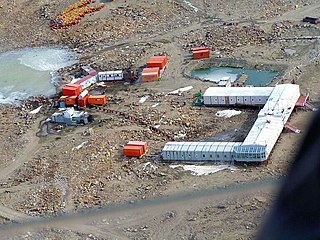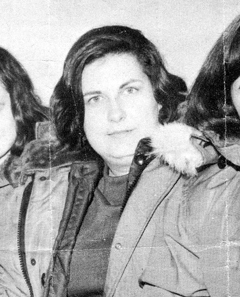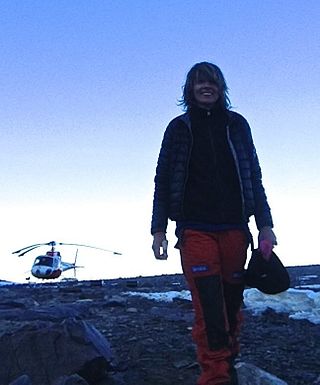Related Research Articles

Dakshin Gangotri was the first scientific base station of India situated in Antarctica, part of the Indian Antarctic Programme. It is located at a distance of 2,500 kilometres (1,600 mi) from the South Pole. It is currently being used as a supply base and transit camp. The base is named after Dakshin Gangotri Glacier.

Maitri also known as Friendship Research Centre, is India's second permanent research station in Antarctica as part of the Indian Antarctic Programme. The name was suggested by then-Prime Minister Indira Gandhi. Work on the station was first started by the Indian Expedition which landed there in the end December 1984, with a team led by Dr. B. B. Bhattacharya. Squadron Leader D. P. Joshi, the surgeon of the team, was the first camp commander of the tentage at camp Maitri. The first huts were started by the IV Antarctica Expedition and completed in 1989, shortly before the first station Dakshin Gangotri was buried in ice and abandoned in 1990–91. Maitri is situated in the rocky mountainous region called Schirmacher Oasis. It is only 5 kilometres (3.1 mi) away from the Russian Novolazarevskaya Station.

The Indian Antarctic Programme is a multi-disciplinary, multi-institutional programme under the control of the National Centre for Polar and Ocean Research, Ministry of Earth Sciences, Government of India. It was initiated in 1981 with the first Indian expedition to Antarctica. The programme gained global acceptance with India's signing of the Antarctic Treaty and subsequent construction of the Dakshin Gangotri Antarctic research base in 1983, superseded by the Maitri base from 1989. The newest base commissioned in 2012 is Bharati, constructed out of 134 shipping containers. Under the programme, atmospheric, biological, earth, chemical, and medical sciences are studied by India, which has carried out 40 scientific expeditions to the Antarctic.

Jasodhara Bagchi was a leading Indian feminist professor, author, critic and activist. She was the founder and director of the School of Women's Studies at Jadavpur University. Her books include Loved and Unloved – The Girl Child and Trauma and Triumph – Gender and Partition in Eastern India. She also founded the women's rights organization Sachetana.
Women in geology concerns the history and contributions of women to the field of geology. There has been a long history of women in the field, but they have tended to be under-represented. In the era before the eighteenth century, science and geological science had not been as formalized as they would become later. Hence early geologists tended to be informal observers and collectors, whether they were male or female. Notable examples of this period include Hildegard of Bingen who wrote works concerning stones and Barbara Uthmann who supervised her husband's mining operations after his death. Mrs. Uthmann was also a relative of Georg Agricola. In addition to these names varied aristocratic women had scientific collections of rocks or minerals.

Maria Vasilyevna Klenova was a Russian and Soviet marine geologist and one of the founders of Russian marine science and contributor to the first Soviet Antarctic atlas.

The Schirmacher Oasis is a 25 km (16 mi) long and up to 3 km (1.9 mi) wide ice-free plateau with more than 100 freshwater lakes. It is situated in the Schirmacher Hills on the Princess Astrid Coast in Queen Maud Land in East Antarctica and is, on average, 100 m (330 ft) above sea level. With an area of 34 km2 (13 sq mi), the Schirmacher Oasis ranks among the smallest Antarctic oases and is a typical polar desert.
Reena Kaushal Dharmshaktu is the first Indian woman to ski from coast of Antarctica to South Pole covering a distance of 900 kilometers.
Aditi Pant, is an Indian oceanographer. She was the first Indian woman to visit Antarctica, alongside geologist Sudipta Sengupta in 1983 as part of the Indian Antarctic Program. She has held prominent positions at institutions including the National Institute of Oceanography, National Chemical Laboratory, University of Pune, and Maharashtra Academy of Sciences.

Lois M. Jones was an American geochemist who led the first all-woman science team to Antarctica in 1969. They were also the first women to reach the South Pole. Jones was well regarded for her contribution to geological research in the McMurdo Dry Valleys, one of the few ice-free areas of Antarctica, and published many papers and abstracts.
Sophie Warny is a Belgian Antarctic researcher, best known for her work on palynology. As an associate professor at Louisiana State University in the Department of Geology and Geophysics and one of the curators at the Museum of Natural Science, Warny studies past climate change patterns by examining fossilized pollen and spores. She is currently the vice president of the Gulf Coast Section of the Society for Sedimentary Geology (GCSSEPM).

Laura Crispini is an Italian geologist and an Antarctic researcher. Her areas of expertise are for the Tectonics, Geodynamics and Geological Mapping including the Geology of Antarctica. She has been nominated among 150 International representative of female Antarctic researchers for the SCAR "Celebration of Women in Antarctic Research" wikibomb event. At present she is Professor at the University of Genoa at the Department for Earth Sciences, Envinronment and life (DISTAV).

This is a Timeline ofwomen in Antarctica. This article describes many of the firsts and accomplishments that women from various countries have accomplished in different fields of endeavor on the continent of Antarctica.
Kshitindramohan Naha (1932–1996) was an Indian geologist and a professor and CSIR Emeritus scientist at the Indian Institute of Technology, Kharagpur. He was known for his studies on structural geology of Precambrian era and was an elected fellow of the Indian National Science Academy, and the Indian Academy of Sciences. The Council of Scientific and Industrial Research, the apex agency of the Government of India for scientific research, awarded him the Shanti Swarup Bhatnagar Prize for Science and Technology, one of the highest Indian science awards for his contributions to Earth, Atmosphere, Ocean and Planetary Sciences in 1972.

Subir Kumar Ghosh (1932–2008) was an Indian structural geologist and an emeritus professor at Jadavpur University. He was known for his studies on theoretical and experimental structural geology and was an elected fellow of the Indian National Science Academy, and the Indian Academy of Sciences. The Council of Scientific and Industrial Research, the apex agency of the Government of India for scientific research, awarded him the Shanti Swarup Bhatnagar Prize for Science and Technology, one of the highest Indian science awards for his contributions to Earth, Atmosphere, Ocean, and Planetary Sciences in 1977.
Hassan Nasiem Siddique (1934–1986) was an Indian marine geologist and the director of the National Institute of Oceanography. He was the deputy leader of the first Indian expedition to the Antarctica during 1981–82. He was known for his geological studies on Bay of Bengal and the Arabian Sea and was an elected fellow of the Indian National Science Academy, Geological Society of India, Association of Exploration Geophysicists and the National Academy of Sciences, India. The Council of Scientific and Industrial Research, the apex agency of the Government of India for scientific research, awarded him the Shanti Swarup Bhatnagar Prize for Science and Technology, one of the highest Indian science awards for his contributions to Earth, Atmosphere, Ocean and Planetary Sciences in 1978. The Government of India awarded him the fourth highest Indian civilian honour of Padma Shri in 1983.
Nibir Mandal is an Indian structural geologist and a professor of Geological Sciences at Jadavpur University. He is known for his studies on the evolution of geological structures and is an elected fellow of Indian Academy of Sciences, and the Indian National Science Academy. The Council of Scientific and Industrial Research, the apex agency of the Government of India for scientific research, awarded him the Shanti Swarup Bhatnagar Prize for Science and Technology, one of the highest Indian science awards for his contributions to Earth, Atmosphere, Ocean and Planetary Sciences in 2005.
Aparna Kumar is an Indian mountaineer. She was awarded the Tenzing Norgay National Adventure Award in 2018 for land adventure by the President of India.
References
- ↑ "Smart Women Scientist who made India proud - Dr. Aditi Pant". ww.itimes.com. 18 May 2015. Retrieved 5 June 2016.
- 1 2 Sengupta, Sudipta. Antarctica. Ananda Publisher, 1989, ISBN 81-7066-091-2
- 1 2 Doney, Anjali (20 August 2019). "Exclusive: From Physicists to Geologists, Meet 6 Amazing Antarctic Women of India". The Better India.
- 1 2 3 Aishwarya, Tripathi (2 November 2019). "Sudipta Sengupta's Journey in Geology to the Ends of the Earth". The Wire.
- ↑ Chaturvedi, Arun (2004). "Indian Women in Antarctic Expeditions: A Historical Perspective". Department of Ocean Development, Technical Publication. 17: 277–279.
- ↑ Tiwari, Anju (2008). Story of Antarctica. Goa: National Centre for Antarctic and Ocean Research. ISBN 978-81-906526-0-5.